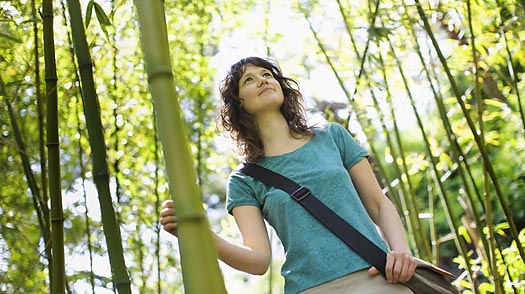
Depressed people often need someone to hug. On occasion, that someone may just be a tree.
A new and growing group of psychologists believes that many of our modern-day mental problems, including depression, stress and anxiety, can be traced in part to society’s increasing alienation from nature. The solution? Get outside and enjoy it.
While traditional psychotherapists focus their treatments on the patient’s interior — whether through pharmaceuticals like Prozac, mindfulness practices like meditation, or old-fashioned couch-bound therapy by the hour — practitioners of the burgeoning field of eco-therapy believe that patient care must include time spent in the great outdoors. “It’s psychotherapy — as if nature really mattered,” says Linda Buzzell-Saltzman, a psychologist and the founder of the International Association for Ecotherapy, which currently lists slightly more than 100 official members.
Eco-therapists point out that human beings have evolved in synchrony with nature for millions of years and that we are hard-wired to interact with our environment — with the air, water, plants, other animals. But in the past two centuries, beginning with the Industrial Revolution, people have been steadily removed from the natural world, our lives regulated not by the sun or moon but instead by the factory clock. Recently it’s gotten worse, with the rise of the Internet and other technologies, like iPhones and BlackBerrys, that dominate our lives, pushing us even further from any appreciation of our natural surroundings.
“We began to get the impression that we were somehow above and separate from nature,” says Craig Chalquist, an instructor at John F. Kennedy University in San Francisco and co-editor with Buzzell-Saltzman of the new book Ecotherapy: Healing with Nature in Mind.
Today, more than half of the world’s population lives in cities, and many people barely ever get a glimpse of green. At the same time, human beings appear to be doing their best to destroy what remains of the earth by contributing to climate change — a problem that in itself causes some people deep anxiety. But what the average person feels as stress or depression, eco-therapists suggest, is a longing for our natural home. “People were embedded in nature once,” says Buzzell-Saltzman. “We’ve lost that, and we’re paying the price.”
Getting it back doesn’t have to be difficult, according to eco-therapists, most of whom, unsurprisingly, practice in California. Patients’ treatment typically begins with starting a nature journal, in which they record how much time they spend outside. The results can often be shocking, says Buzzell-Saltzman. “Some patients find they spend less than 15 to 30 minutes a day outside, other than walking to and from their cars,” she says. Eco-therapists counsel patients to slow down and reconnect with nature by hiking, gardening or simply taking walks outdoors. Therapy sessions may also take place outdoors — in a park, for example — rather than inside yet another office. “We can use the natural world to be part of the healing process,” says Chalquist. “We have to acknowledge that we’re part of this, not the master of it.”
If such prescriptions sound a little simplistic, consider this: A 2007 study by researchers at the University of Essex in England found that a daily dose of walking outside could be as effective as taking antidepressant drugs for treating mild to moderate depression. Of course, it’s no secret that regular exercise is a powerful mood enhancer — although researchers noted that a similar regimen of walking in a crowded shopping mall did not have the same impact — and the boost in vitamin D production in people who spent more time outside in the sun surely helped as well.
It may be that eco-therapy is less a practical psychological treatment than a timely philosophy that connects common feelings of isolation and stress with the fact that the world in which we live is slowly becoming something it shouldn’t be. And with worsening climate change and a relentless drumbeat of bad news about our endangered environment, it seems our eco-anxiety may be far from being cured. “Ultimately, what we need to do is change human behavior,” says Buzzell-Saltzman — a commonsense recommendation for humans as well as the environment.
See pictures of the world’s most polluted places.
See pictures of the effects of global warming.
See TIME’s environment covers.